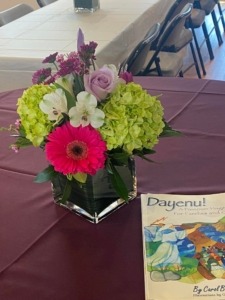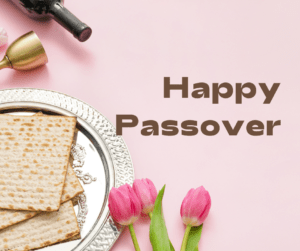 When I was a kid, we celebrated Passover at my aunt and uncle’s house every year. I have so many fond memories of sitting in their huge dining room surrounded by my entire family. Besides my wedding day, I’m not sure I’ve ever been in a room that was more filled with love. I was raised as a Conservative Jew, which is somewhere in between – “they tried to kill us, let’s eat” and a four-hour Seder.
When I was a kid, we celebrated Passover at my aunt and uncle’s house every year. I have so many fond memories of sitting in their huge dining room surrounded by my entire family. Besides my wedding day, I’m not sure I’ve ever been in a room that was more filled with love. I was raised as a Conservative Jew, which is somewhere in between – “they tried to kill us, let’s eat” and a four-hour Seder.
I still see my uncle at the head of the table leading the service with my aunt by his side (occasionally running to the kitchen to check on dinner). I don’t know how he got a room full of people to pay attention and participate fully, but I was always impressed at how engaged we all were in our traditions. I also remember wondering who would carry on these traditions when we grew up. Who would cook? Who would host? Who would lead the Seder?
Back then, I don’t know if anyone would have picked me to host and lead the Seder when we had our own families. I was not the most knowledgeable or the most outgoing as a child. I didn’t attend a Jewish overnight camp or a fancy synagogue. I’m also not the best cook, so with all of these factors working against me, I would have thought myself the least likely of the next generation to host one of the most important holidays on the Jewish calendar.
But here I am, 30 years later, writing this while gazing up at my dining room table set for 20 people. This year, we postponed our second Seder to Saturday when my kids can be home. The Haggadahs* are out. The seder plates, matzah covers, wine glasses, and candles are unpacked and ready to fulfill their duties. Thankfully, my family contributes the best homemade Passover food to the big meal. My aunt and cousin are making delicious brisket. (My attempts to make brisket have failed miserably over the years, so I have delegated this responsibility to the experts). My mom is bringing her famous honey carrots, matzah ball soup, and her tasty roasted chicken and vegetables. My mother-in-law and I take care of the side dishes—pineapple kugel, veggie souffle, and sweet and sour meatballs. And my sister-in-law channels her beloved grandmother and bakes the most incredible desserts. No one would think the cakes and cookies she brings are Kosher for Passover. Yeah, they are that good!
As for me, I’m cleaning up and shopping various markets to buy everything we need for the Seder. I have the matzah, the hard-boiled eggs, the parsley, the salt water, the charoset, the bitter herbs, and of course, the wine. I have also led the Seder, which has evolved over the years. My husband and I raised our kids as Reform Jews, so our service lasts about 30 minutes, and then we eat. But this year, we are doing things a little differently.
My daughter, Jenna, has compiled a social justice-themed Haggadah for her campus Hillel’s Seder. We will expand our horizons a little by connecting the Passover story to some of the issues facing our world today, like food insecurity, climate change, and human rights. Jenna is a sociology major, and social justice is one of her passions.
Did I mention yet how proud I am of her for putting this together?! I read through the service today and cried a few tears of joy. When I called to tell her how much I loved it, she told me that when she has a house someday, she will host Passover just like we do. I admit that I teared up even more when she said that.
Thirty years ago, I was sitting at my aunt and uncle’s Seder table. Now, I’m hosting the Seder at my house, and my daughter has volunteered to keep our traditions alive for the next generation. It just doesn’t get any better than that.
*For those who don’t celebrate this holiday, the Haggadah is the book we use to tell the Passover story. It includes the blessings, the story of how we were slaves in Egypt and the Exodus to freedom in Israel, and different songs and readings. The Seder takes place at home with family and friends and includes the telling of the story and a festive dinner.

 Passover begins tonight, and I’m ready for a little holiday spirit. This year, I’m being very intentional about staying present and enjoying the moment. I work as a communications director for a Jewish organization, and most of the time, I’m planning content two holidays ahead of where we are right now. Because of my line of work, holidays tend to pass me by, one after the next, without a lot of time for personal fulfillment. I guess you could call it an occupational hazard.
Passover begins tonight, and I’m ready for a little holiday spirit. This year, I’m being very intentional about staying present and enjoying the moment. I work as a communications director for a Jewish organization, and most of the time, I’m planning content two holidays ahead of where we are right now. Because of my line of work, holidays tend to pass me by, one after the next, without a lot of time for personal fulfillment. I guess you could call it an occupational hazard. 1 Long Day at Work
1 Long Day at Work